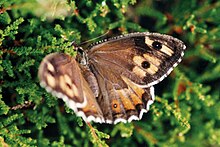| Grayling | |
|---|---|

| |
| Female | |

| |
| male, Portugal | |
| Scientific classification | |
| Domain: | Eukaryota |
| Kingdom: | Animalia |
| Phylum: | Arthropoda |
| Class: | Insecta |
| Order: | Lepidoptera |
| Family: | Nymphalidae |
| Genus: | Hipparchia |
| Species: | H. semele
|
| Binomial name | |
| Hipparchia semele | |
The grayling or rock grayling (Hipparchia semele) is a species in the brush-footed butterfly family Nymphalidae.[1] Although found all over Europe, the grayling mostly inhabits coastal areas, with inland populations declining significantly in recent years.[1][2] The grayling lives in dry and warm habitats with easy access to the sun, which helps them with body temperature regulation.[1][2]
A grayling goes through four stages in its life cycle. The eggs hatch around August, and larvae grow in four instars from August to the following June. By June, the larvae begin to pupate by spinning a silk cocoon below the surface of the ground. The adult grayling emerges around August.[1] The grayling migrates in small groups of two or three butterflies throughout most of August, typically moving southeast.[3]
H. semele engages in cryptic coloring, with their tan and brown colored wings helping them camouflage into their surroundings. The grayling exposes the eyespots on its wings when it believes to have been detected by a predator, but generally keeps them hidden to avoid being seen.[4] Male butterflies are territorial, and engage in flight performances to determine who settles in the best oviposition site.[5] Additionally, the grayling regulates its body temperature by orienting its body and posture to adjust to the heat from the sun.[2]
Grayling populations have recently begun to decline, and while it is not globally endangered, the species is now considered a priority for conservation efforts in the United Kingdom.[1]
- ^ a b c d e f van Swaay, C.; Wynhoff, I.; Verovnik, R.; Wiemers, M.; López Munguira, M.; Maes, D.; Sasic, M.; Verstrael, T.; Warren, M.; Settele, J. (2010). "Hipparchia semele". IUCN Red List of Threatened Species. 2010: e.T173254A6980554. doi:10.2305/IUCN.UK.2010-1.RLTS.T173254A6980554.en. Retrieved 12 November 2021.
- ^ a b c Cite error: The named reference
:1was invoked but never defined (see the help page). - ^ Cite error: The named reference
:5was invoked but never defined (see the help page). - ^ Cite error: The named reference
:6was invoked but never defined (see the help page). - ^ Cite error: The named reference
:3was invoked but never defined (see the help page).
